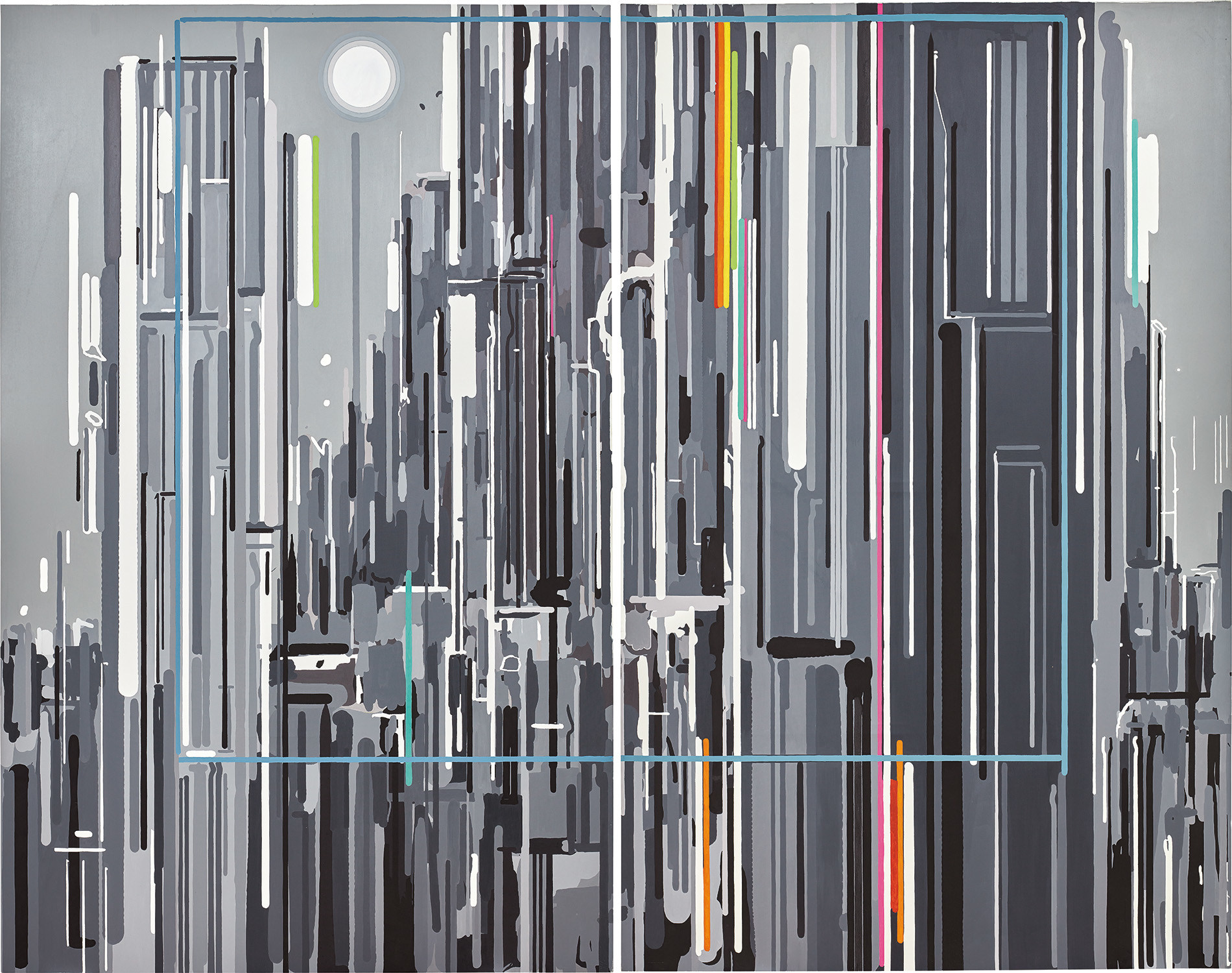



19
Liu Wei
Purple Air III No. 2 (diptych)
oil on canvas
each 301.6 x 190.4 cm (118 3/4 x 74 7/8 in.)
overall 301.6 x 380.8 cm. (118 3/4 x 149 7/8 in.)
overall 301.6 x 380.8 cm. (118 3/4 x 149 7/8 in.)
Painted in 2006.
Full-Cataloguing
Liu Wei leads a contemporary generation of avant-garde Chinese artists forging a new vocabulary inspired by Western artistic references, forgoing the “Made-in-China” iconography, eluding a national narrative while alluding to their environs. A multifaceted artist and a thinker, Liu Wei continually pushes the boundaries in his pursuit of the ‘visual truth’ (Hans Ulrich Obrist, ‘Hans Ulrich Obrist: Interviews Liu Wei’, in The China Interviews, Hong Kong, March 2012, online). It is this search that links his diverse practices across paintings, photography, video, sculpture, and installation. ‘I don’t begin from a material or a technique and then think about what I want to do. Rather, I have an idea and then think about how to express it’ (Jerome Sans, ‘Liu Wei, an interview’, in China Talks, Beijing, 2009, p. 41).
Executed in 2006, Purple Air III No. 2 is from Liu Wei’s seminal series of the same name. Cityscape dominates this impressively sized diptych. Sharp lines and stacked columns rendered in monochromatic shades of grey and punctured by sporadic verticals of bright white, yellow, orange and red evoke soaring skyscrapers. A round shape referencing the sun or the moon glow through the enveloping hazy air, opaque grey tinged with a purple hue. Dark specks hover nearby, reminiscent of birds. A large blue rectangle superimposed across suggests a window through which the spectator peers, catching a glimpse of the sprawling metropolis. Geometric abstraction amplifies the verticality of the urban architecture. There is a brutal modernity to this systematic, grid-like composition. Aptly, Liu’s working method consists of first creating a design using computer-generated pixels and patterns, before transposing onto canvas.
The Purple Air series began in 2005, a time of Liu Wei’s emergence onto the international art scene and conceptual shift towards a more subtle narrative. Liu’s motif of a cityscape reduced to geometric abstraction has since reappeared in various painting series and installations.
It is unclear whether Purple Air III No.2 is a metaphor or indictment. Liu Wei candidly admitted that although the idea of pollution in Chinese cities crossed his mind, his rendering of buildings and cities is rooted in his belief that they represent the blueprint of human existence. The title emanates from the Chinese saying ‘purple air comes from the east’ (紫氣東來) that augurs an auspicious omen. ‘In the Chinese classics, this idea of purple air refers to a state of haze, a lack of clarity, but actually full of vitality. There are so many problems, but it is still lovely’ (Jerome Sans, ‘Liu Wei, an interview’, in China Talks, Beijing, 2009, p. 43).
‘I am with the viewers, in the quest for meaning. I hope the viewers could use my works as starting points or points of reference in their discussions, contributing to their own thinking. In this sense, art means freedom. Not only am I free as a creator, the viewers are free as spectators as well.’ (Sam Gaskin, ‘Liu Wei in Conversation’, in Ocula, 1 April 2015).
Executed in 2006, Purple Air III No. 2 is from Liu Wei’s seminal series of the same name. Cityscape dominates this impressively sized diptych. Sharp lines and stacked columns rendered in monochromatic shades of grey and punctured by sporadic verticals of bright white, yellow, orange and red evoke soaring skyscrapers. A round shape referencing the sun or the moon glow through the enveloping hazy air, opaque grey tinged with a purple hue. Dark specks hover nearby, reminiscent of birds. A large blue rectangle superimposed across suggests a window through which the spectator peers, catching a glimpse of the sprawling metropolis. Geometric abstraction amplifies the verticality of the urban architecture. There is a brutal modernity to this systematic, grid-like composition. Aptly, Liu’s working method consists of first creating a design using computer-generated pixels and patterns, before transposing onto canvas.
The Purple Air series began in 2005, a time of Liu Wei’s emergence onto the international art scene and conceptual shift towards a more subtle narrative. Liu’s motif of a cityscape reduced to geometric abstraction has since reappeared in various painting series and installations.
It is unclear whether Purple Air III No.2 is a metaphor or indictment. Liu Wei candidly admitted that although the idea of pollution in Chinese cities crossed his mind, his rendering of buildings and cities is rooted in his belief that they represent the blueprint of human existence. The title emanates from the Chinese saying ‘purple air comes from the east’ (紫氣東來) that augurs an auspicious omen. ‘In the Chinese classics, this idea of purple air refers to a state of haze, a lack of clarity, but actually full of vitality. There are so many problems, but it is still lovely’ (Jerome Sans, ‘Liu Wei, an interview’, in China Talks, Beijing, 2009, p. 43).
‘I am with the viewers, in the quest for meaning. I hope the viewers could use my works as starting points or points of reference in their discussions, contributing to their own thinking. In this sense, art means freedom. Not only am I free as a creator, the viewers are free as spectators as well.’ (Sam Gaskin, ‘Liu Wei in Conversation’, in Ocula, 1 April 2015).